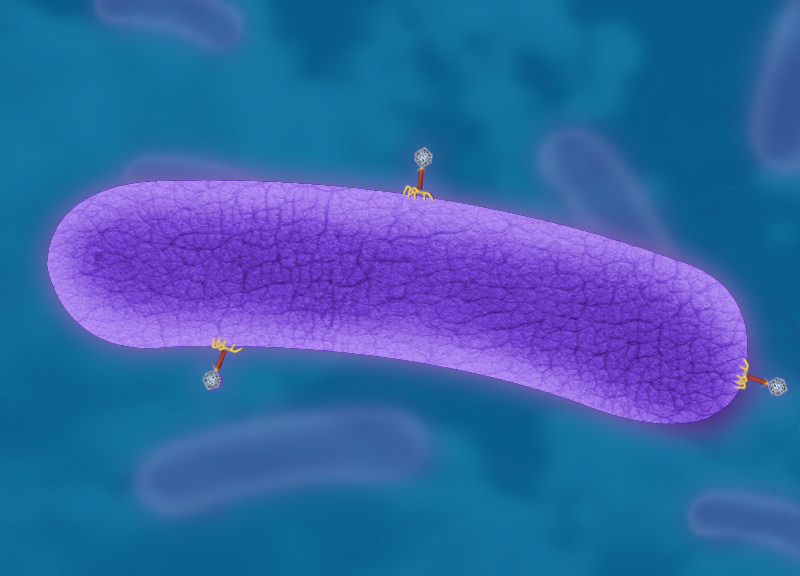7.13 病毒复制
章节大纲
-
Notice the viruses sitting on the bacteria?
::注意到细菌上的病毒吗?Why is the sitting here? Remember, viruses are not living. So how do they replicate?
::为什么坐在这里?记住,病毒不是活的。它们是如何复制的?Replication of Viruses
::病毒复发of viruses do not grow through because they are not . Instead, they use the machinery and metabolism of a host cell to produce new copies of themselves. After infecting a host cell, a virion uses the cell’s , , ATP , and other components to replicate. Viruses vary in how they do this. For example:
::病毒的生长并不是因为病毒不是病毒。相反,它们利用宿主细胞的机器和新陈代谢来生产新版本。 在感染宿主细胞后,病毒利用细胞、ATP和其他部件复制。 病毒是如何复制的。例如:-
Some
RNA viruses
are translated directly into viral
in ribosomes of the host cell. The host ribosomes treat the viral
as though it were the host’s own mRNA.
::一些RNA病毒在宿主细胞的血浆中直接转化为病毒。 宿主血浆把病毒当作是宿主自己的MRNA。 -
Some
DNA viruses
are first transcribed in the host cell into viral mRNA. Then the viral mRNA is translated by host cell ribosomes into viral proteins.
::一些DNA病毒首先被转录到宿主细胞中的病毒 mRNA。 然后病毒 mRNA被宿主细胞肋骨转化成病毒蛋白。
In either case, the newly made viral proteins assemble to form new virions. The virions may then direct the production of an enzyme that breaks down the host cell wall . This allows the virions to burst out of the cell. The host cell is destroyed in the process. The newly released virus particles are free to infect other cells of the host.
::无论哪种情况,新制造的病毒性蛋白都组装成新的病毒。 病毒性病毒随后可以引导一种酶的生产,它打破了主机细胞的墙壁。 这使得病毒性病毒能够从细胞中爆发出来。 宿主细胞在此过程中被摧毁。 新释放的病毒粒子可以自由感染主机的其他细胞。Replication of RNA Viruses
::RNA病毒的复制An RNA virus is a virus that has RNA as its genetic material . Their is usually single-stranded RNA, but may be double-stranded RNA. Important human pathogenic RNA viruses include the Severe Acute Respiratory Syndrome (SARS) virus, Influenza virus, and Hepatitis C virus. RNA viruses can be placed into different groups depending on their type of replication.
::RNA病毒是一种以RNA为遗传材料的病毒,它们通常是单根RNA,但可能是双层RNA。 重要的人类致病性RNA病毒包括严重急性呼吸系统综合症(SARS)病毒、流感病毒和丙型肝炎病毒。 RNA病毒可以根据其复制类型分为不同的群体。-
Some RNA viruses have their
genome
used directly as if it were mRNA. The viral RNA is translated directly into new viral proteins after infection by the virus.
::一些RNA病毒的基因组被直接使用,仿佛是MRNA。 病毒RNA在病毒感染后被直接转化成新的病毒蛋白质。 -
Some RNA viruses carry enzymes which allow their RNA genome to act as a
template
for the host cell to a form viral mRNA.
::一些RNA病毒携带酶,使得其RNA基因组可以作为主机细胞的模板,形成病毒型MRNA。 -
Retroviruses
use
intermediates to replicate.
Reverse transcriptase
, a viral enzyme that comes from the virus itself, converts the viral RNA into a complementary strand of DNA, which is copied to produce a double stranded molecule of viral DNA. This viral DNA is then transcribed and translated by the host machinery, directing the formation of new virions. Normal
involves the synthesis of RNA from DNA; hence, reverse transcription is the
reverse
of this process. This is an exception to the
central dogma of molecular biology
.
::反转转录入酶是病毒本身产生的病毒酶,它把病毒RNA转换成一种互补的DNA链条,复制以产生一种双倍的受困的病毒DNA分子。然后,这种病毒DNA由主机转录和翻译,引导新病毒的形成。正常状态涉及从DNA中合成RNA;因此,反转录入是这一过程的反向。这是分子生物学核心教条的例外。
Replication of DNA Viruses
::DNA病毒的复制A DNA virus is a virus that has DNA as its genetic material and replicates using a DNA-dependent DNA polymerase. The nucleic acid is usually double-stranded DNA but may also be single-stranded DNA. The DNA of DNA viruses is transcribed into mRNA by the host cell. The viral mRNA is then translated into viral proteins. These viral proteins then assemble to form new viral particles.
::DNA病毒是一种病毒,其基因材料是DNA,并使用依靠DNA的DNA聚合酶复制。核酸通常是双层DNA,但也可能是单层DNA。DNA病毒的DNADNA由主机细胞转录到 mRNA。病毒的MRNA随后被转化成病毒蛋白。这些病毒蛋白质会聚集成新的病毒粒子。Reverse-Transcribing Viruses
::反反制病毒A reverse-transcribing virus is any virus which replicates using reverse transcription, the formation of DNA from an RNA template. Some reverse-transcribing viruses have genomes made of single-stranded RNA and use a DNA intermediate to replicate. Others in this group have genomes that have double-stranded DNA and use an RNA intermediate during genome replication. The retroviruses, as mentioned above, are included in this group, of which is a member. Some double-stranded DNA viruses replicate using reverse transcriptase. The hepatitis B virus is one of these viruses.
::反转录入病毒是指使用逆转转录入法复制的任何病毒,这种病毒是从RNA模板中形成DNA。一些反转录入的病毒有单层RNA制成的基因组,并使用DNA中间体复制。这一组的其他人有具有双层DNA的基因组,并在基因组复制过程中使用RNA中间体。如上所述,反转病毒也包含在这个组中,该组是其成员之一。一些双层DNA病毒使用逆转转转录入法复制。乙型肝炎病毒是这些病毒之一。Bacteriophages
::细菌Bacteriophages are viruses that infect . They bind to surface receptor molecules of the bacterial cell and then their genome enters the cell. The protein coat does not enter the bacteria. Within a short amount of time, in some cases, just minutes, bacterial polymerase starts translating viral mRNA into protein. These proteins go on to become either new virions within the cell, helper proteins which help assembly of new virions, or proteins involved in cell lysis. Viral enzymes aid in the breakdown of the . With some phages , just over twenty minutes after the phage infects the bacterium, over three hundred phages can be assembled and released from the host.
::细菌是感染病毒的病毒。它们与细菌细胞的表面受体分子结合,然后它们的基因组进入细胞。蛋白外衣没有进入细菌。在很短的时间内,有时只是几分钟,细菌聚合酶开始将病毒MRNA转化为蛋白质。这些蛋白质要么成为细胞内新的病毒,要么成为帮助组装新病毒的帮助性蛋白质,或者成为细胞解析过程中的蛋白质。病毒酶有助于细胞的分解。一些phages,在细胞感染细菌后仅超过20分钟,就可以从宿主那里组装和释放超过300个phage。Summary
::摘要-
After infecting a host cell, a virus uses the cell’s machinery and metabolism to produce new copies of itself.
::病毒在感染宿主细胞后,利用细胞的机械和新陈代谢来产生新版本。
Review
::回顾-
In general terms, describe viral replication.
::概括地说,描述病毒复制。 -
Describe how DNA viruses replicate.
::描述DNA病毒是如何复制的。 -
What are reverse-transcribing viruses?
::什么是反导病毒?
-
Some
RNA viruses
are translated directly into viral
in ribosomes of the host cell. The host ribosomes treat the viral
as though it were the host’s own mRNA.
